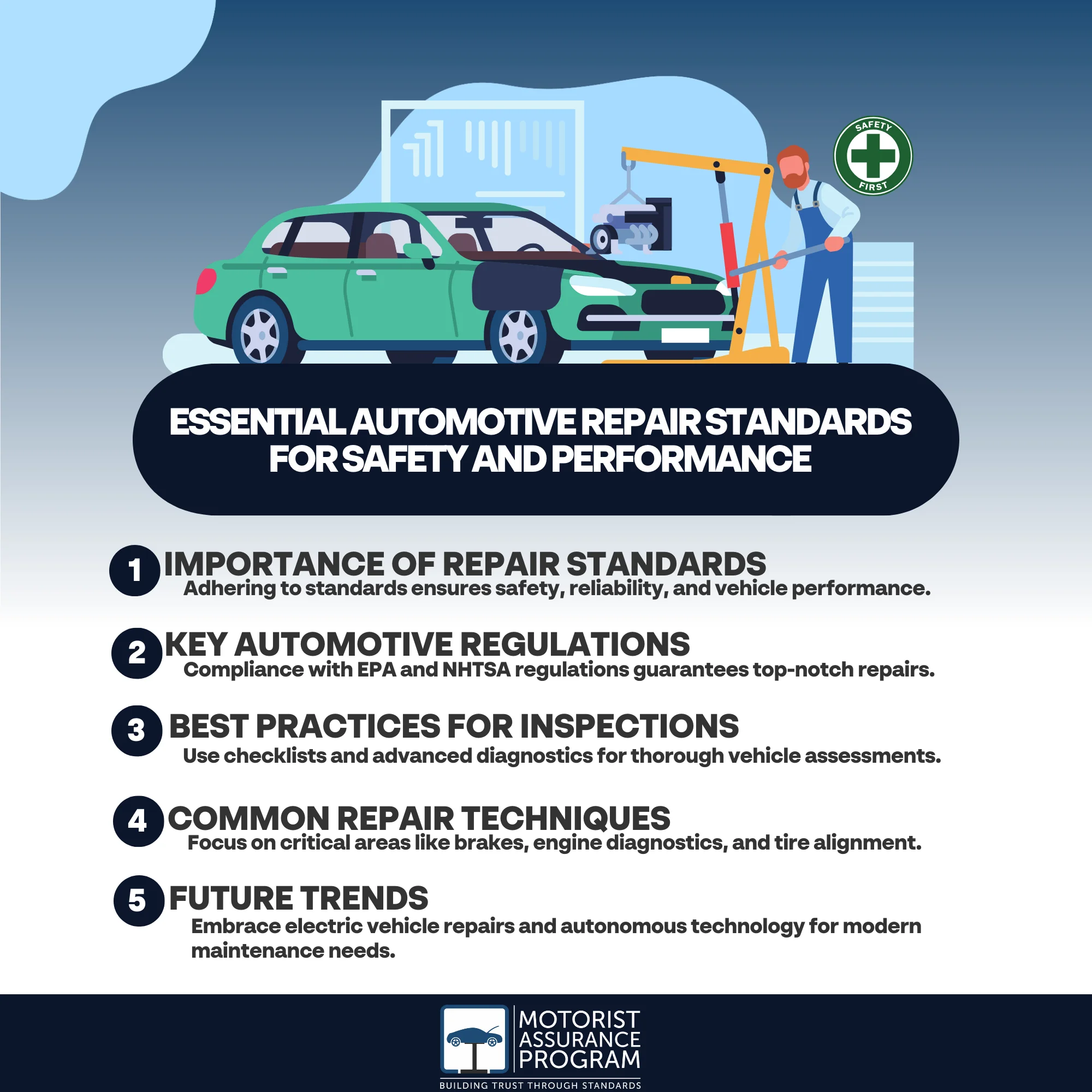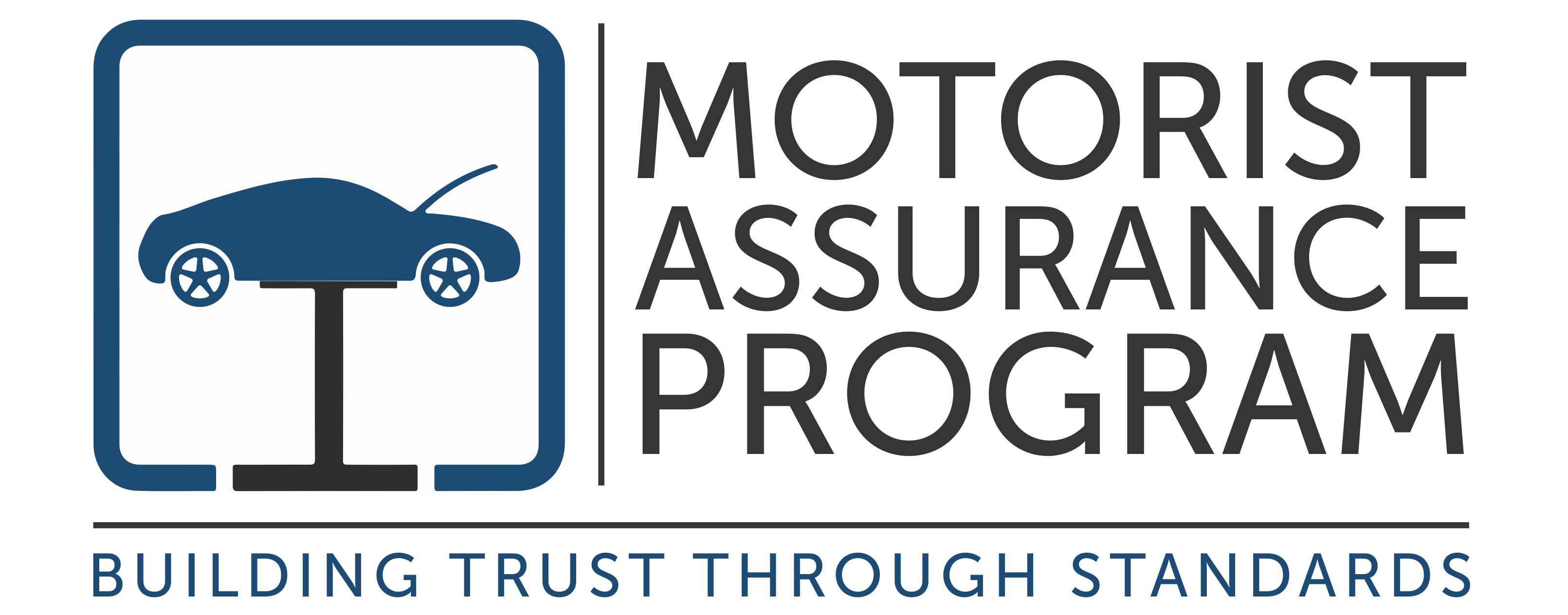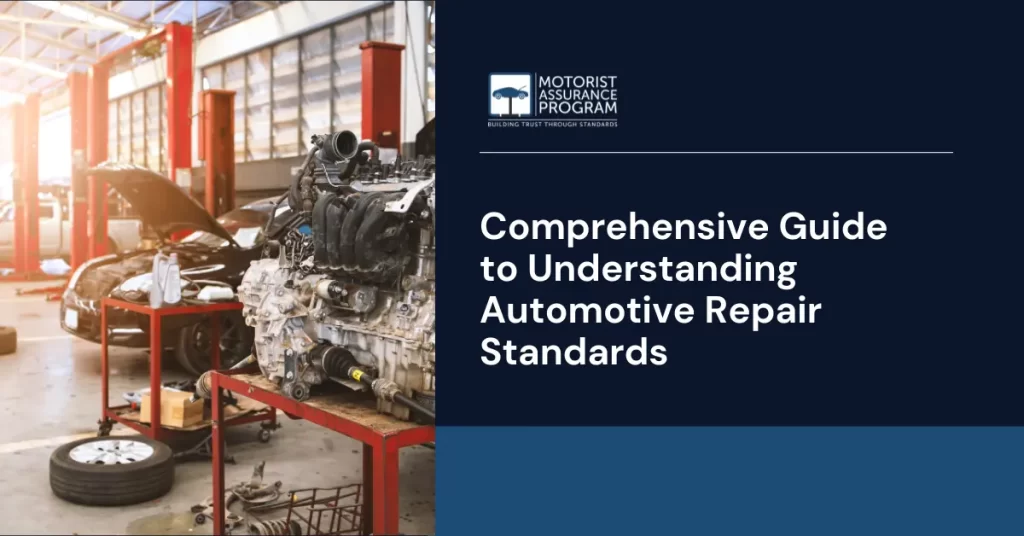A complete guide to automotive repair standards is essential for ensuring your vehicle’s safety and performance. These standards help mechanics follow specific guidelines, using quality parts, which enhances your vehicle’s reliability and fuel economy. Key regulations from agencies like the EPA and NHTSA enforce compliance, ensuring technicians are certified and repairs are documented. Best practices include thorough inspections and open communication with your mechanic to catch issues early. With advancements in technology, mechanics are also becoming more tech-savvy. Understanding these aspects can empower you as a vehicle owner and keep your ride in top condition. Keep exploring to uncover more insights!

Key Takeaways
-
Automotive repair standards ensure safety, reliability, and performance, mandating the use of quality parts and adherence to specific guidelines.
-
Regulatory agencies like EPA and NHTSA enforce compliance with regulations covering emissions, safety features, and repair practices.
-
Certified technicians play a crucial role in maintaining proper repairs, ensuring vehicle longevity and adherence to industry standards.
-
Regular inspections using checklists and advanced diagnostic tools help identify issues early, supporting effective maintenance and repair practices.
-
Future trends in automotive repair include a focus on electric vehicle systems, autonomous technology, and the need for tech-savvy mechanics.
Importance of Repair Standards
Repair standards play an important role in the automotive industry, guaranteeing safety, reliability, and performance for every vehicle on the road. When you understand the significance of these standards, you realize how they directly impact repair quality and customer trust.
High repair standards mean that mechanics follow specific guidelines, using quality parts and techniques that meet or exceed industry expectations. This consistency not only improves the performance of your vehicle but also guarantees that it remains safe to drive. Furthermore, adhering to these standards can greatly enhance fuel economy, which is essential for both environmental sustainability and cost savings for consumers, as highlighted by resources on fuel economy information.
As a car owner, you want to feel confident about the repairs your vehicle undergoes. When automotive shops adhere to established repair standards, they build a solid foundation of trust with you, their customer. You know that your car is being treated with care and expertise.
This trust is critical; it encourages you to return to the same shop for future repairs and maintenance, fostering long-term relationships based on reliability.
In a world where vehicle performance can profoundly affect your daily life, prioritizing repair standards is important. By choosing shops that uphold these standards, you’re not just guaranteeing your vehicle’s safety; you’re also supporting a culture of excellence in the automotive industry.
Key Automotive Repair Regulations
Numerous key automotive repair regulations are in place to guarantee that vehicles are maintained and repaired to the highest standards. As a car owner, it’s vital to understand these rules to ascertain your vehicle’s safety and performance.
Regulatory agencies, such as the Environmental Protection Agency (EPA) and the National Highway Traffic Safety Administration (NHTSA), oversee compliance with these standards. They enforce regulations that cover everything from emissions to safety features.
Repair certifications play an important role in this framework. Certified technicians possess the necessary training and expertise to perform repairs correctly. When you choose a repair shop with certified professionals, you’re not just getting a service; you’re investing in your vehicle’s longevity and reliability.
Moreover, these regulations often require repair facilities to keep detailed records of services performed, which can help protect you in case of disputes.
By being informed about these key regulations, you empower yourself as a vehicle owner. You’ll know what to expect and can confidently advocate for your vehicle’s needs.
Best Practices for Inspections
When it comes to vehicle inspections, adhering to best practices is essential for ensuring both safety and performance. Start by using thorough inspection checklists tailored to your specific vehicle type. These checklists help you systematically evaluate each component, from brakes to lights, ensuring nothing gets overlooked.
Next, utilize advanced diagnostic tools that provide real-time data on your vehicle’s health. These tools can help pinpoint issues more accurately than a visual inspection alone, allowing you to address problems before they escalate. Regularly updating your skills and knowledge about these tools can dramatically enhance your inspection process.
Don’t forget to document your findings meticulously. Keeping a record of inspections not only helps you track maintenance but can also be beneficial for resale value.
Additionally, always encourage open communication with your mechanic. If you notice something unusual, don’t hesitate to ask questions—your insights can be invaluable in diagnosing potential issues.
Common Repair Techniques
After guaranteeing your vehicle’s components are in good shape through thorough inspections, it’s time to focus on common repair techniques that can effectively address various issues.
One essential technique is brake repair, which involves checking pads, rotors, and fluid levels to guarantee your safety on the road. Additionally, understanding electric vehicle maintenance is increasingly important as more drivers shift to these advanced technologies.
When problems arise with your engine, conducting engine diagnostics can pinpoint issues quickly, saving you both time and money.
Transmission servicing is another significant area; regular maintenance can prevent costly repairs down the line. If you notice your vehicle’s body has dents or scratches, employing effective bodywork techniques will restore its appearance and value.
Don’t underestimate the importance of electrical troubleshooting either; modern vehicles rely heavily on electrical systems, and diagnosing faults can resolve many frustrating issues.
Lastly, tire alignment is vital for ideal handling and tire longevity. Misalignment can lead to uneven tire wear and affect your vehicle’s performance.
Future Trends in Automotive Repair
As technology rapidly evolves, the landscape of automotive repair is undergoing significant transformations. You’ll notice that the rise of electric vehicle repairs is reshaping the skills technicians need. With more EVs on the road, understanding battery systems and electric drivetrains becomes essential. This shift isn’t just about learning new tools; it’s about embracing a new mindset toward vehicle maintenance.
Moreover, autonomous technology impacts how you think about repairs. As cars become more self-sufficient, the complexity of their systems increases. Technicians will need to adapt, focusing on software updates and intricate sensor calibrations that were previously unheard of in traditional repairs.
This means you may find that your mechanic isn’t just a hands-on worker but also a tech-savvy professional who understands intricate programming.
In this evolving landscape, staying informed and proactive about your vehicle’s needs is more important than ever. Embrace these changes, and remember that investing in your vehicle’s upkeep today will lead to smoother, safer rides tomorrow.
Frequently Asked Questions
What Are the Most Common Automotive Repair Certifications Available?
When exploring automotive repair certifications, you’ll find several types, including ASE, I-CAR, and OEM certifications. These guarantee technicians meet industry standards, enhancing their skills and credibility in a competitive job market.
How Do I Choose a Reputable Repair Shop?
When choosing a repair shop, think of trusted allies in a quest. Check repair shop reviews and customer testimonials; they’ll guide you. Look for certifications and experience, ensuring your ride’s in capable hands.
What Is the Average Cost of Automotive Repairs?
The average cost of automotive repairs varies widely based on repair cost factors like vehicle type and service needed. Regional price variations also play a big role, so it’s best to research local shops for accurate estimates.
How Can I Ensure My Vehicle Meets Repair Standards?
Did you know 90% of vehicles fail inspections due to poor repair quality? To guarantee your vehicle meets repair standards, schedule regular vehicle inspections, keep maintenance records, and choose certified repair shops for the best results.
What Should I Do if My Repair Warranty Is Denied?
If your repair warranty’s denied, review the denial reasons. Gather supporting documents, then contact the provider for dispute resolution. Often, a conversation can clarify misunderstandings and lead to a favorable outcome for you.
Conclusion
As you immerse yourself in the world of automotive repair standards, remember that knowledge is your greatest tool. By embracing these standards, you’re not just fixing vehicles; you’re ensuring safety and reliability on the road. Picture the satisfaction of driving a well-maintained car, knowing you’ve done your part to uphold these essential practices. So, gear up, stay informed, and let your commitment to quality pave the way for a safer driving experience for everyone. The road ahead is in your hands!


